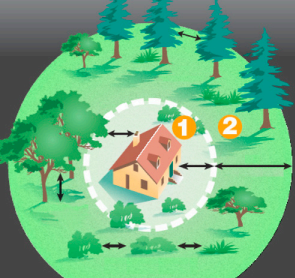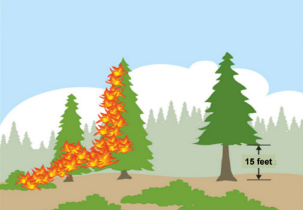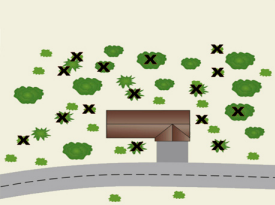by Melody Kendall
I was born and raised here in beautiful Napa Valley. My memory isn't what it used to be, but I am observing that climate change thing is real. When I was little we had sufficient rain in the winter, enough that I could play in the puddles and make mud pies on a regularly. Summer months were warm and sometimes hot, but lacked the pesky wind that seems so common now. The wind dries everything out and turns the grass brown much earlier than I remember.

So, what to do? Remember when you were learning to drive and you were encouraged to be a defensive driver, to be aware of your surroundings and plan for surprises? That's the example we would do well to follow. We all need to be defensive gardeners in this changing new world. Look at your home and the surrounding landscape and plan for surprises.
According to UCANR publication "Home landscaping for Fire" our area has more than 1,445 structures destroyed by wildfire each year. This publication also states that homeowners who take defensive gardening to heart and use careful pruning and landscaping techniques can minimize the spread of fire and have a better chance of saving their homes and structures. Grasses, brush, trees and other vegetation surrounding your home can become dangerous fuel sources for fire. So, create a defensive space around your home by removing, pruning or otherwise altering the vegetation in the landscape areas directly adjacent to your home.

In a fire safe landscape there are two zones around your home: the home defense zone and the reduced fuel zone. Number 1, the home defense zone, is a circle 30 feet equidistant from the outside walls of the structure. Number 2, the reduced fuel zone, extends out from that 30 foot home defense zone to 100 feet out and beyond. If your structure is on a windswept area or a slope allow for a larger defensive space.

Consider fire resistant plants, note the "resistant" description. Anything will burn if it gets hot enough so no plant is fireproof. Check the plant description. Many nurseries and informational materials have begun to include that notation when describing a plant that fulfills the fire resistant criteria. They are slow and low growing, open structured and have less resinous leaves and branches. The leaves have a high moisture content, little or no seasonal debris (leaves, fruit etc) and have open branching habits with fewer branches and leaves. Deciduous trees are considered more fire resistant than evergreen trees because the leaves have a higher moisture content. Remember that the placement and management of these plants is also key.
Maintaining a healthy greenbelt of low growing groundcovers and/or lawns will provide a high moisture belt around your home. Using a drip system to target the water needs would conserve water and somewhat mitigate the water usage concerns. Low grown shrubs planted at least 10 feet from the house in similar height groups can create a pleasing and fire wise landscape. Using mulch conserves water so for a firewise landscape use rock mulches or low growing ground cover to cover bare weedy soil. In a fire situation wood mulches will smolder and be hard to extinguish. For any walkways use decorative rocks, gravel or stepping stones to break up the landscape to create further fire wise options. Avoid planting near wood siding, under vents or eaves or under or near a deck and don't allow tree limbs to extend over the roofline.
The reduced fuel zone is the area beyond the 30 foot home defense zone which extends an additional 70-100 feet out from the structure. In this area the trees should be thinned from 10 to 20 feet apart between branches and if the trees are over 18 feet trim branches on the trunk up to 6-15 feet from the ground. Remove any brush from around the base of all trees. Because of their flammability shrubs should not be used as screens around structures, propane tanks or other flammable materials. Only plant varieties of shrubs that are low growing, deciduous and non resinous and space them widely apart.
Yearly maintenance and cleanup is a must. Any yard waste is a fire hazard. Keep your plants green with supplemental water, if necessary, during fire season and mow any grasses when green to reduce sparking by mowing blades. All that debris under your deck needs to be cleared out and removed and trees and shrubs kept trimmed annually to ensure that fire safe spacing is maintained.
Many people move to the country to experience the wide open spaces and the accompanying privacy. Vegetative screens and using fire resistant plants are fine, just make sure they are at least 100 feet from your home and are well outside your defensible space. If your parcel is larger than an acre, fire safe landscaping suggests that you treat the vegetation in a defensive manner all the way to the property line. Most city and county governments require regular mowing so be sure to check those regulations to be compliant.
How much or how little defensive landscaping you do is dependent on how much you are adverse to losing your home. To do all you can to prepare and protect your home and landscape from fire is to design your home and landscape using fire safe materials. Keep the surrounding area clear of fire fuel by planting only fire resistant varieties using the correct spacing. Keep your trees trimmed, all plants hydrated and healthy and clear any debris on a regular basis.
Your home is your castle and your safe place. With the increased prevalence of fires we should all do what we can to reduce any fuel for fire on our properties by using these defensive landscaping methods. Pass this information on to your friends and neighbors.
Napa Master Gardeners are available to answer garden questions by email: mastergardeners@countyofnapa.org. or phone at 707-253-4143. Volunteers will get back to you after they research answers to your questions.
Visit our website: napamg.ucanr.edu to find answers to all of your horticultural questions.
Photo credits: Information link: UC ANR home landscaping for fire
https://anrcatalog.ucanr.edu/pdf/8228.pdf